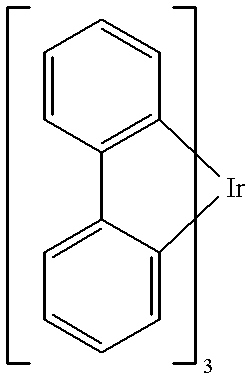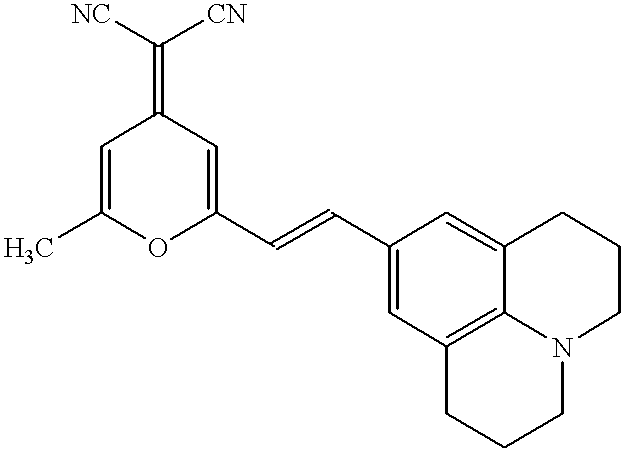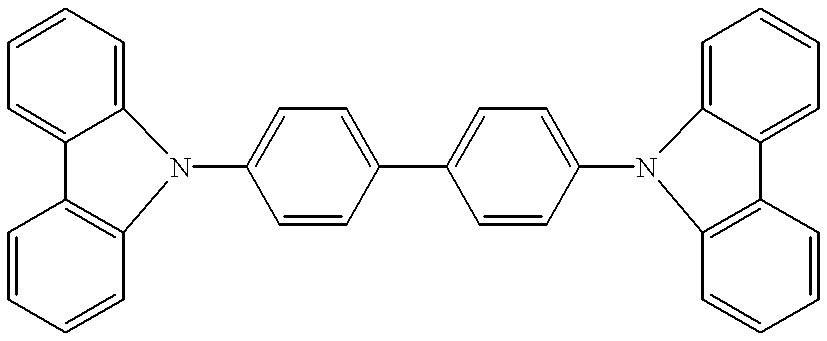Intersystem crossing agents for efficient utilization of excitons in organic light emitting devices
a technology of organic light emitting devices and inter-system crossing agents, which is applied in the direction of organic semiconductor devices, thermoelectric devices, luminescent compositions, etc., can solve the problems of wasting energy in the triplet state, slow and inefficient luminescence, and few other problems
- Summary
- Abstract
- Description
- Claims
- Application Information
AI Technical Summary
Benefits of technology
Problems solved by technology
Method used
Image
Examples
example 1
Organic layers were deposited by a high vacuum (10.sup.-6 Torr) thermal evaporation onto a clean glass substrate pre-coated with a 1400 .ANG.-thick layer of transparent and conductive indium tin oxide. A 600 .ANG.-thick layer of N,N'-diphenyl-N,N'-bis(3-methylphenyl)-[1,1'-biphenyl]-4,4'-diamine ["TPD"] is used to transport holes to the luminescent layer. The luminescent layer consisted of an alternating series of 10 .ANG.-thick layers of CBP doped to 10% (by mass) of Ir(ppy).sub.3, and 10 .ANG. thick layers of CBP doped to 1% (by mass) of DCM2. In total, 10 doped layers were grown, with a total thickness of 100 .ANG.. Excitons were confined within the luminescent region by a 200 .ANG.-thick layer of the exciton-blocking material 2,9-dimethyl-4,7-diphenyl-1,10-phenanthroline (also called bathcuproine, or BCP). A 300 .ANG.-thick layer of the electron transport material tris-(8-hydroxyquinoline) aluminum ("Alq.sub.3 ") is used to transport electrons to the luminescent region and to re...
second embodiment
V.B.2. Example of Second Embodiment
Prophetic Example 4.
An OLED is fabricated with a traditional diamine hole transporter and an electron transporting layer (ETL) composed of three different materials. The ETL is roughly 80% a traditional electron transporting material (such as Zrq4), 15% an intersystem crossing agent (such as benzil; other ISC agents may be found in the reference of Gilbert and Baggott) and 5% a phosphorescent emitter (such as PtOEP, platinum octaethyl porphyrin). The ISC agent is chosen so that its absorption spectrum overlaps strongly with the ETL's fluorescence spectrum. Hole electron recombination occurs at or near the HTL / ETL interface generating a mixture of singlet and triplet excitons. The singlet excitons on the ETL will efficiently transfer their energy to the ISC agent, which will efficiently intersystem cross to its triplet state, via a n.fwdarw..pi.* state or some other suitable process.
The triplet energy of the ISC agent will then transfer to the dopan...
example 5
In FIGS. 5 and 6, we present control experiments for a device without a phosphorescent dopant emitter. An example of the third embodiment can have a phosphorescent emitter in the ETL layer.
The structure of the device for this example is given schematically in FIG. 5. It is made of a heterostructure with .alpha.-NPD / ISC-F / Alq3. (The Alq3 layer is not doped). The IV characteristic of the device is given in FIG. 6. The device area here is 3.14 mm.sup.2. The key point is that there is no light at low to medium bias. This result shows that the ISC filter / converter certainly quenches singlets. [At very high biases (>17 Volts) weak green emission can be observed. The spectrum of this output shows that it is from Alq3. To explain the emission, either there are electrons leaking through to Alq3 at high bias or the ISC-F is transferring energy back to the singlet in Alq3.]
In the device corresponding to the third embodiment of the present invention, the Alq3 region is doped with a phosphoresce...
PUM
 Login to View More
Login to View More Abstract
Description
Claims
Application Information
 Login to View More
Login to View More - R&D
- Intellectual Property
- Life Sciences
- Materials
- Tech Scout
- Unparalleled Data Quality
- Higher Quality Content
- 60% Fewer Hallucinations
Browse by: Latest US Patents, China's latest patents, Technical Efficacy Thesaurus, Application Domain, Technology Topic, Popular Technical Reports.
© 2025 PatSnap. All rights reserved.Legal|Privacy policy|Modern Slavery Act Transparency Statement|Sitemap|About US| Contact US: help@patsnap.com



